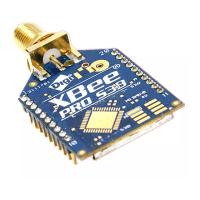Network configurations Basic communications
XBee®-PRO 900HP/XSC RF Modules
235
Configure remote nodes as destinations (MD = 4). This ensures that the remote node waits for the
repeater traffic to subside before transmitting a response.
The preceding configuration instructions reflect configuration for a Basic Broadcast Repeater system.
To configure a Basic Addressed Repeater system, use the DT (Destination Address) parameter to
assign unique addresses to each device in the network.
Algorithm details
n Packet ID (PID) consists of the transmitting device MY address and packet serial number.
n Devices ignore incoming packets with a PID already found in the PID buffer.
n Each device maintains a PID buffer 8 deep of previously received packets (managed as FIFO).
Packets may be shifted out the serial port and/or repeated depending on the DT parameter contained
in the RF packet.
The following table shows the DT (Destination Address) parameter truth.
Address match Send out serial port? Repeat?
Global Yes Yes
Local Yes Yes
None No Yes
Repeat delay based on RSSI
A transmitted packet may be received by more that one repeater at the same time. To reduce the
probability of repeaters transmiting at the same time that may result in a collision and possible data
loss, an algorithm allows a variable back-off prior to retransmission of the packet by a repeater.
Devices that receive the packet with a stronger RF signal (RSSI) have the first opportunity to
retransmit the packet.
Use the RN (Delay Slots) parameter to configure the delay.
n Set RN=0 (no delays) for small networks with few repeaters or repeaters that are not within
range of each other.
n Set RN=1 for systems with 2 to 5 repeaters that may be within range of each other.
Use the following formula to compute the actual length of the delay:
Delay (ms) = L * DS
DS = (-41-RSSI)/(10*RN)+RandomInt(0,RN)
Where:
n L is the length of the transmitted packet in milliseconds.
n DS is the number of delay slots to wait.
n RSSI is the received signal strength in dBm.
n RN is the value of the RN register.
n RandomInt(A,B) is a function that returns a random integer from A to B-0.
Response packet delay
As a packet propagates through the repeater network, if any node receives the data and generates a
quick response, the response must be delayed so it does not collide with subsequent retransmissions

